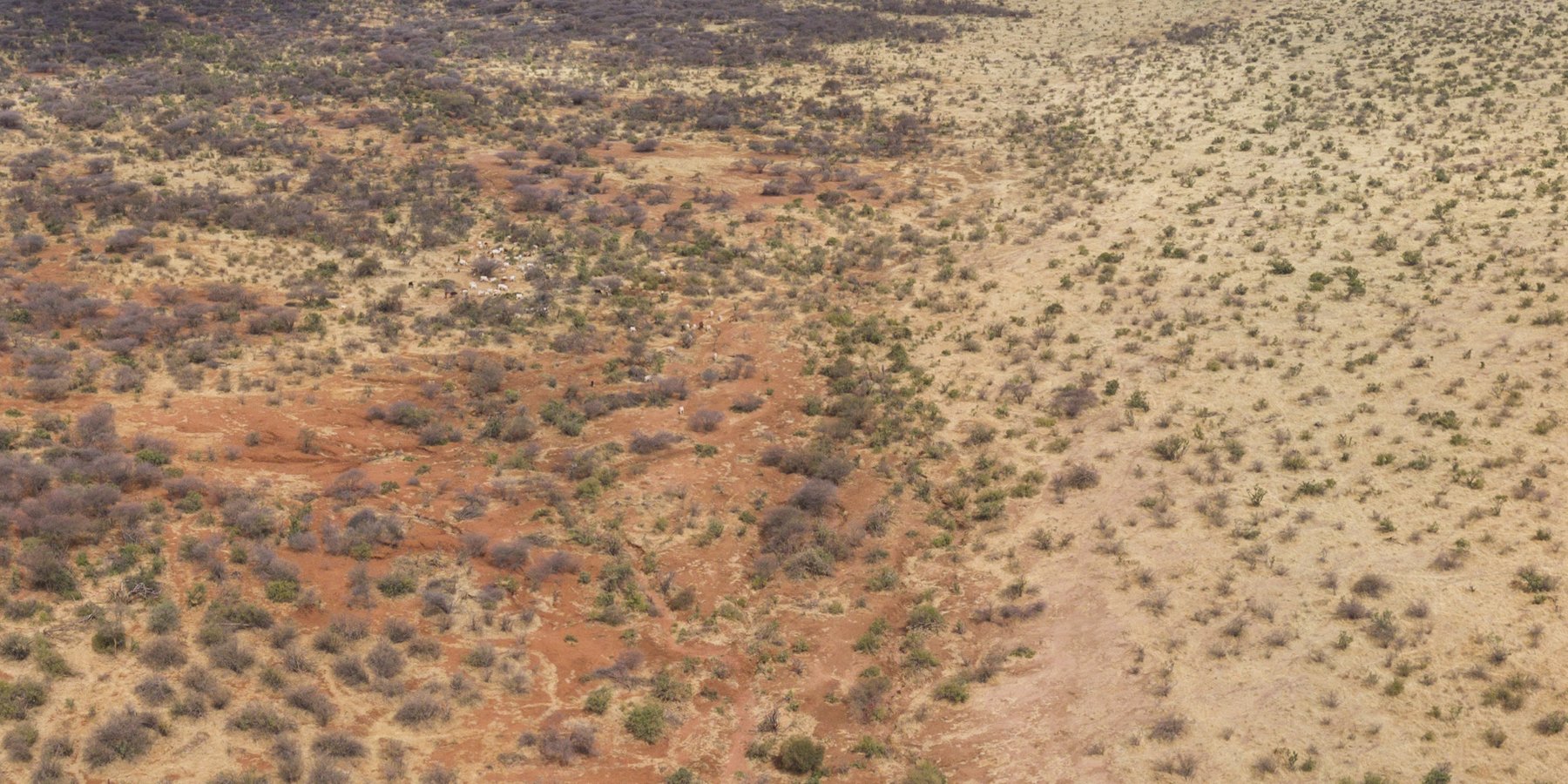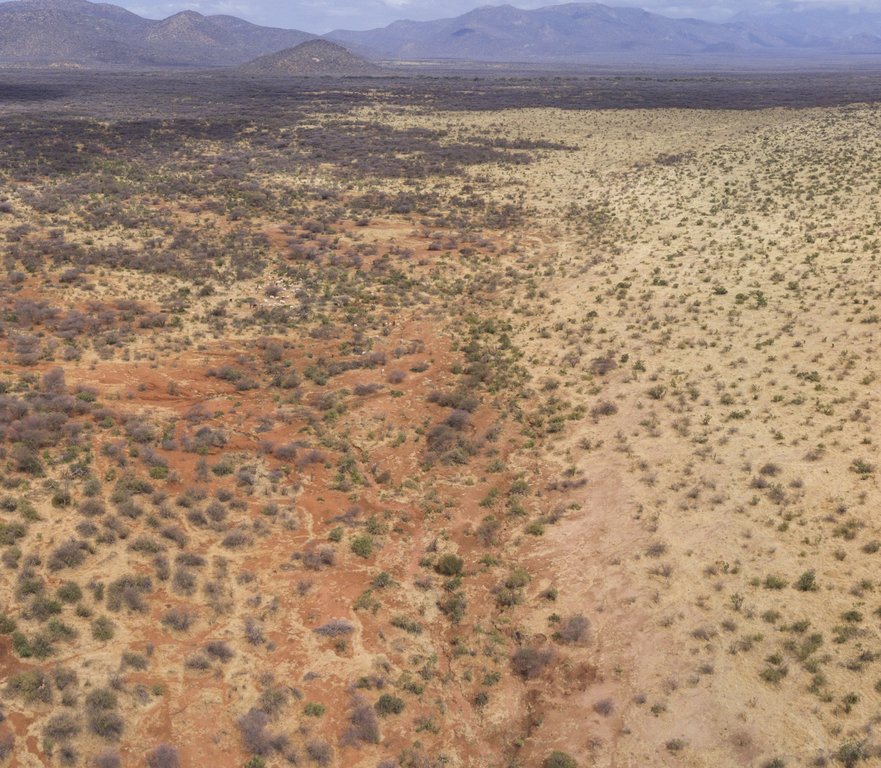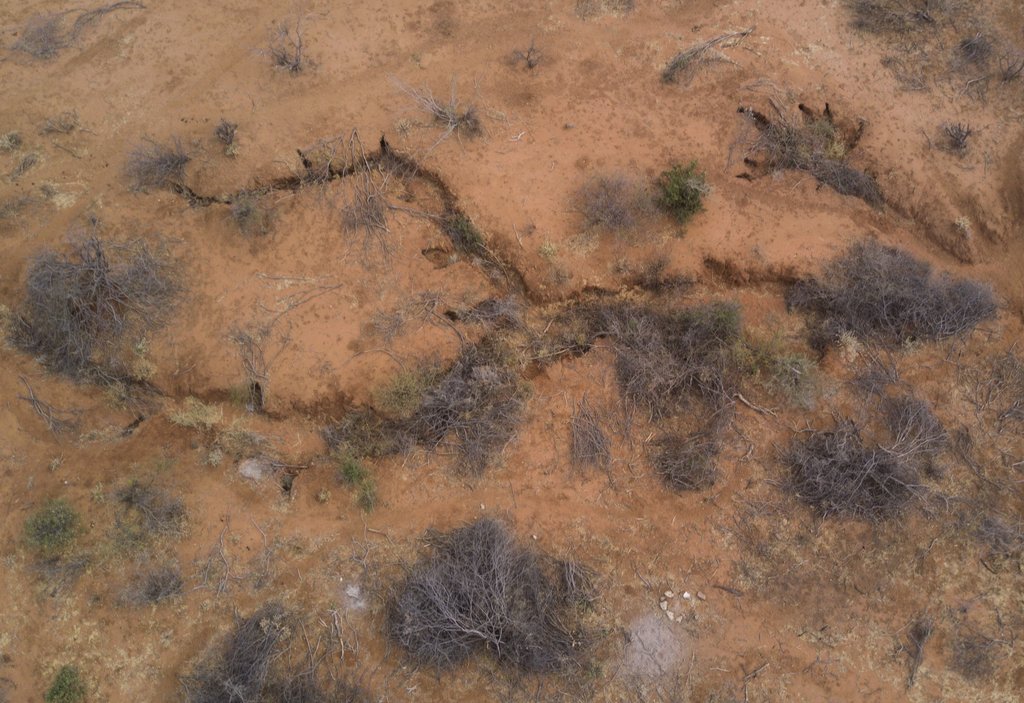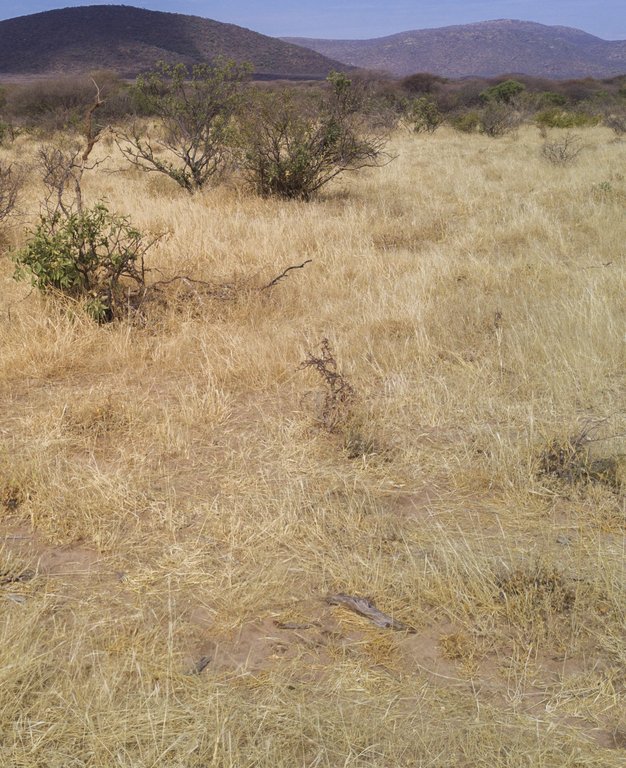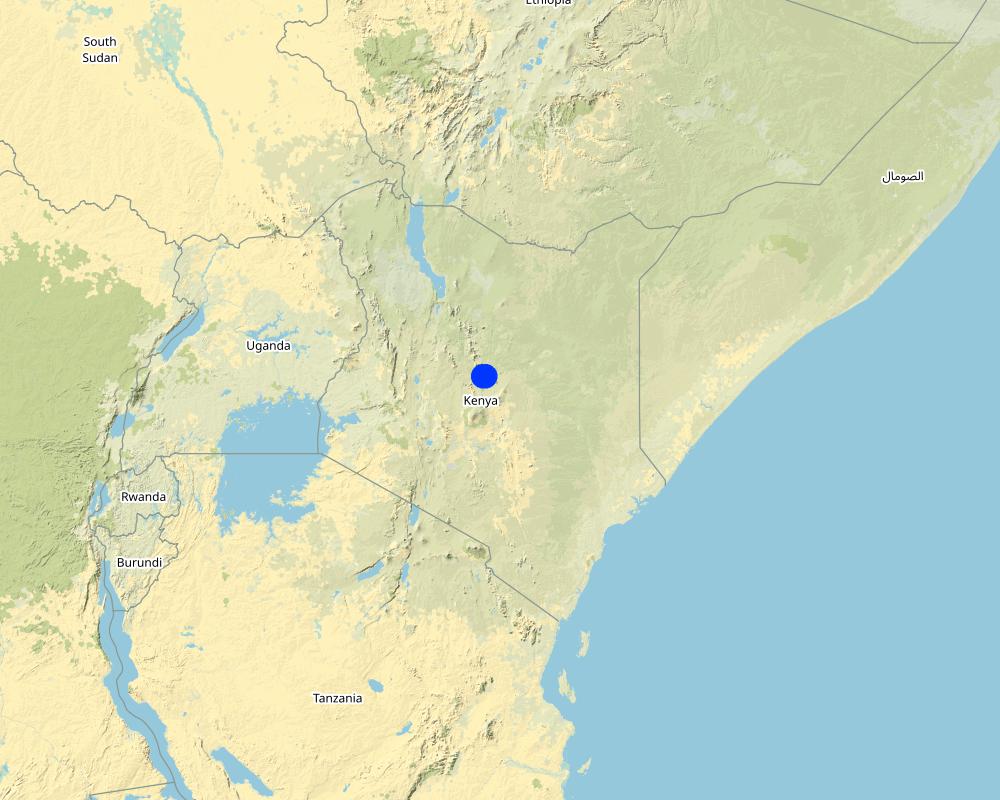Rangeland Restoration by cutting invasive species and grass reseeding and managing grazing [ប្រទេសកេនយ៉ា]
- ការបង្កើត៖
- បច្ចុប្បន្នភាព
- អ្នកចងក្រង៖ Harry Wells
- អ្នកកែសម្រួល៖ –
- អ្នកត្រួតពិនិត្យច្រើនទៀត៖ Alexandra Gavilano, Donia Mühlematter, Barbara *, Rima Mekdaschi Studer, Hanspeter Liniger, Joana Eichenberger
technologies_3381 - ប្រទេសកេនយ៉ា
- សង្ខេបជា PDF
- សេចក្តីសង្ខេបពេញលេញជាទម្រង់ PDF សម្រាប់បោះពុម្ព
- សេចក្តីសង្ខេបពេញលេញទម្រង់អ៊ីនធឺនេត
- សេចក្តីសង្ខេបពេញលេញ (មិនមានទម្រង់ជាក់លាក់)
- Rangeland Restoration by cutting invasive species and grass reseeding and managing grazing: 16 ខែ កក្កដា ឆ្នាំ 2018 (inactive)
- Rangeland Restoration by cutting invasive species and grass reseeding and managing grazing: 6 ខែ ឧសភា ឆ្នាំ 2019 (inactive)
- Rangeland Restoration by cutting invasive species and grass reseeding and managing grazing: 3 ខែ កញ្ញា ឆ្នាំ 2018 (inactive)
- Rangeland Restoration by cutting invasive species and grass reseeding and managing grazing: 2 ខែ វិច្ឆិកា ឆ្នាំ 2021 (public)
- Rangeland Restoration by cutting invasive species and grass reseeding and managing grazing : 23 ខែ មិនា ឆ្នាំ 2018 (inactive)
ពិនិត្យមើលគ្រប់ផ្នែក
ពង្រីកមើលទាំងអស់ បង្រួមទាំងអស់1. ព័ត៌មានទូទៅ
1.2 ព័ត៌មានលម្អិតពីបុគ្គលសំខាន់ៗ និងស្ថាប័នដែលចូលរួមក្នុងការវាយតម្លៃ និងចងក្រងឯកសារនៃបច្ចេកទេស
co-compiler:
ឈ្មោះគម្រោងដែលបានចងក្រងឯកសារ/ វាយតម្លៃលើបច្ចេកទេស (បើទាក់ទង)
Book project: Guidelines to Rangeland Management in Sub-Saharan Africa (Rangeland Management)1.3 លក្ខខណ្ឌទាក់ទងទៅនឹងការប្រើប្រាស់ទិន្នន័យដែលបានចងក្រងតាមរយៈ វ៉ូខេត
អ្នកចងក្រង និង(បុគ្គលសំខាន់ៗ)យល់ព្រមទទួលយកនូវលក្ខខណ្ឌនានាទាក់ទងទៅនឹងការប្រើប្រាស់ទិន្នន័យដែលបានចងក្រងតាមរយៈវ៉ូខេត:
បាទ/ចា៎
1.4 សេចក្តីប្រកាសស្តីពីចីរភាពនៃការពណ៌នាពីបច្ចេកទេស
តើបច្ចេកទេសដែលបានពណ៌នានេះមានបញ្ហាដែលផ្តោតលើការធ្លាក់ចុះគុណភាពដី, បើដូច្នេះវាមិនអាចត្រូវបានប្រកាសថាជាបច្ចេកទេសនៃការគ្រប់គ្រងប្រកបដោយចីរភាពទេ?
ទេ
2. ការពណ៌នាពីបច្ចេកទេស SLM
2.1 ការពណ៌នាដោយសង្ខេបពីបច្ចេកទេស
និយមន័យបច្ចេកទេស:
This 'Rangeland Restoration' technology is part of a 'Holistic Rangeland Management' approach. It involves clearing of invasive vegetation (predominantly Acacia reficiens) and reseeding with grass (Cenchrus ciliaris) and allowing resting and reduced grazing pressure to rehabilitate degraded communal grazing land.
2.2 ការពណ៌នាលម្អិតពីបច្ចេកទេស
ការពណ៌នា:
The 'Rangeland Restoration' technology is applied in degraded sites within the 3,100 Ha 'core conservation area' (an central area with minimised grazing pressure designated for tourism) and 'buffer zone' (an area surrounding the 'core conservation area' with reduced grazing pressure) of the Kalama Community Wildlife Conservancy (total area: 9,500 Ha).
The main characteristics are clearing of invasive woody vegetation (predominantly Acacia reficiens) and reseeding with grass (Cenchrus ciliaris). Acacia reficiens (commonly known as red-bark acacia, red thorn or false umbrella tree or thorn) is a native tree or shrub but is considered an invasive species as it can encroach degraded areas with bare and disturbed soil. It is very opportunistic and hardy and can subsequently take over large areas of native vegetation. The invasion can reach a closed or nearly closed canopy with A. reficiens thickets, which are hindering animals to enter and access fodder thus making the area inaccessible for grazing and browsing. Additionally it can be observed that the soil underneath the canopy remains bare and the grass growth seems to be suppressed. As a result the top soil is compacted or forms crusts, which hinder infiltration. During the erratic but heavy rains most of the water flows away as runoff (research in close by areas show that runoff is between 60-80 % of the rainfall) and increases soil erosion and further degradation of the land despite a rather good tree cover. Rangeland grass and fodder productivity in these areas are reduced to a fraction of their potential.
The main activity is the cutting of the trees and shrubs at a height of ~1 m. The main trunks and branches can be used for fencing, temporary house constructions, firewood and charcoal. Most of the cut trees and the remaining branches are used to spread on the bare land where the trees and shrubs are cut. Underneath this dead material the bare soil receives some cover, which creates favorable conditions and microclimate for termites and other fauna in the soil to brake the hard top soil and crust and enable infiltration of the water during the next rains. This allows regrowth of grasses, particularly in the areas protected by the branches. In the following seasons the spread of the grasses can increase also the the area not protected by the branches. Additionally, seeding with Cenchrus ciliaris (buffel-grass or African foxtail grass), a grass species which is native to most of Africa, enhances the growth of a highly valuable fodder grass. Seeds are hand-broadcasted in the treated areas and germinate during the next rainy season. The first greening is visible in the places where the branches and the wood pieces cover the soil. From there the local annual and perennial grasses start colonising and expanding in the following seasons until, ideally, the whole area that has been bare is covered by valuable perennial grasses. Parallel to the cutting and reseeding is reduced grazing pressure and a resting period over at least one dry season, which is facilitated by the fact that treated areas are situated in the core conservation area or in the buffer zone. This involves the cooperation of the members of Kalama Conservancy, who agree to restrict grazing in the buffer zone and more so in the core conservation area. The exact duration that grazing is allowed in each of these two areas varies year to year depending on drought severity and forage availability. Whereas the grazing pressure by livestock can be regulated, there remains uncontrolled grazing by wildlife. The major herbivores are zebra, elephants and a number of different gazelle and antelope species the grazing pressure by wildlife varies but can be substantial at certain times.
Rehabilitating degraded grazing land is the primary purpose of the technology. Other benefits of the technology include: 1) augmented forage availability for the community; 2) increased livestock production; 3) reduced soil erosion and flooding. Land users enjoy these benefits but would like larger areas to be similarly restored. However, the limiting factor is the funding required to pay for labour, which is the major input required for the clearing and reseeding activities. Establishing a market for removing the main stems and producing and selling charcoal is still an opportunity to further explore immediate benefits and cash income in order to pay for the investment into the clearing.
2.3 រូបភាពនៃបច្ចេកទេស
2.5 ប្រទេស/តំបន់/ទីតាំងកន្លែង ដែលបច្ចេកទេសត្រូវបានអនុវត្ត និងបានគ្រប់ដណ្តប់ដោយការវាយតម្លៃនេះ
ប្រទេស:
ប្រទេសកេនយ៉ា
តំបន់/រដ្ឋ/ខេត្ត:
Samburu County
បញ្ជាក់ពីការសាយភាយនៃបច្ចេកទេស:
- អនុវត្តនៅកន្លែងជាក់លាក់មួយ/ ប្រមូលផ្តុំនៅតំបន់តូចៗ
Map
×2.6 កាលបរិច្ឆេទនៃការអនុវត្ត
បង្ហាញឆ្នាំនៃការចុះអនុវត្ត:
2006
ប្រសិនបើមិនច្បាស់ឆ្នាំ សូមបញ្ជាក់កាលបរិច្ឆេទដែលប្រហាក់ប្រហែល:
- 10-50 ឆ្នាំ
2.7 ការណែនាំពីបច្ចេកទេស
សូមបញ្ជាក់តើបច្ចេកទេសត្រូវបានណែនាំឱ្យអនុវត្តដោយរបៀបណា:
- តាមរយៈគម្រោង / អន្តរាគមន៍ពីខាងក្រៅ
មតិយោបល់ (ប្រភេទនៃគម្រោង ។ល។):
Acacia reficiens was already selectively cleared traditionally when constructing livestock corrals ('bomas'), but the introduction of more extensive clearing and grass-reseeding to rehabilitate specific areas was facilitated by Northern Rangeland Trust and Grevy's Zebra Trust.
3. ចំណាត់ថ្នាក់នៃបច្ចេកទេស SLM
3.1 គោលបំណងចម្បង (១ ឬច្រើន) នៃបច្ចេកទេសនេះ
- កាត់បន្ថយ, បង្ការ, ស្តារឡើងវិញនូវការធ្លាក់ចុះគុណភាពដី
- អភិរក្សប្រព័ន្ធអេកូឡូស៊ី
- អភិរក្ស/ធ្វើឱ្យប្រសើរឡើងជីវចម្រុះ
3.2 ប្រភេទដីប្រើប្រាស់មួយប្រភេទ (ច្រើនប្រភេទ) ដែលបានអនុវត្តបច្ចេកទេស

ដីសម្រាប់ចិញ្ចឹមសត្វ
វាលស្មៅធំៗ:
- ពាក់កណ្តាលពនេចរ
- បែងចែកវាលស្មៅជាប្លុក
ប្រភេទសត្វ:
- សត្វពាហនៈ - សត្វចិញ្ចឹមមិនយកទឹកដោះតែសម្រាប់យកសាច់
- សត្វពាហនៈ - សត្វចិញ្ចឹមយកទឹកដោះ
- សត្វពពែ
- សត្វអូដ្ធ
- សត្វលា
- សត្វចៀម
ផលិតផល និងសេវាកម្ម:
- ទឹកដោះគោ
- សាច់

ដីខ្សោះជីជាតិ
សូមបញ្ជាក់:
Bare and/or degraded land
កំណត់សម្គាល់:
The area has been overused and continuously grazed for a long period of time without given the land and vegetation a break to recover. Thus a vicious spiral developed: the reduced grass cover lead to degradation of the soil to compaction and crusting, reduced infiltration thus reduced runoff and reduced vegetation growth, which in turn increased the pressure on the remaining vegetation and thus more base soil etc.
មតិយោបល់:
Number of growing seasons per year: 2
Specify: Rainiy seasons from April to June and from October to December but with high variability in time and amount
Livestock density: likely continuously growing till technology was introduced
3.4 ការផ្គត់ផ្គង់ទឹក
ការផ្គត់ផ្គង់ទឹកនៅកន្លែងអនុវត្តបច្ចេកទេស:
- ទឹកភ្លៀង
3.5 ក្រុម SLM ដែលបច្ចេកទេសស្ថិតនៅក្នុង
- កសិរុក្ខកម្ម (pastoralism) និងការគ្រប់គ្រងដីសម្រាប់ចិញ្ចឹមសត្វ
- ធ្វើឱ្យប្រសើរឡើងគម្របដី/ ដំណាំគម្របដី
- ធ្វើឱ្យប្រសើរឡើងនូវការបង្កាត់ពូជរុក្ខជាតិ/ សត្វ
3.6 វិធានការ SLM ដែលបញ្ចូលនូវបច្ចេកទេស

វិធានការរុក្ខជាតិ
- V2: ស្មៅនិងរុក្ខជាតិៗដែលដុះមានអាយុមិនលើសពី 2ឆ្នាំ
- V4: ការជំនួស ឬការយកចេញនៃប្រភេទរុក្ខជាតិក្រៅស្រុក/ ការរាតត្បាត

វិធានការគ្រប់គ្រង
- M2: ការផ្លាស់ប្តូរការគ្រប់គ្រង/ កម្រិតអាំងតង់ស៊ីតេ
3.7 កំណត់ប្រភេទនៃការធ្លាក់ចុះគុណភាពដីសំខាន់ៗដែលបច្ចេកទេសនេះបានដោះស្រាយ

ការហូរច្រោះដីដោយសារទឹក
- Wt: ការបាត់ដីស្រទាប់លើដោយការហូរច្រោះ
- Wg: ការកកើតឡើងនូវកំទេចកំទីដីស្រទាប់ក្រោម

ការបាត់បង់រូបសាស្ត្រនៃដី
- Pc: ការហាប់ណែន
- Pk: ការបិទរន្ធដី

ការធ្លាក់ចុះជីវសាស្ត្រនៃដី
- Bc: ការថយចុះនូវគម្របរុក្ខជាតិ
- Bs: សមាសភាពដែលមានគុណភាពនិងប្រភេទសត្វ/ការថយចុះនូវជីវចម្រុះ
- Bl: ការបាត់បង់មីក្រូ និងម៉ាក្រូសរីរាង្គរបស់ដី

ការបាត់បង់ទឹក
- Ha: ការថយចុះសំណើមដី
3.8 ការពារ កាត់បន្ថយ ឬស្តារឡើងវិញនៃការធ្លាក់ចុះគុណភាពដី
បញ្ជាក់ពីគោលដៅរបស់បច្ចេកទេស ដែលផ្តោតទៅការធ្លាក់ចុះគុណភាពដី:
- ការកាត់បន្ថយការធ្លាក់ចុះគុណភាពដី
- ការជួសជុល/ ស្តារឡើងវិញនៃឱនភាពដីធ្ងន់ធ្ងរ
4. បច្ចេកទេសជាក់លាក់ សកម្មភាពអនុវត្ត ធាតុចូល និងថ្លៃដើម
4.1 គំនូសបច្ចេកទេសនៃបច្ចេកទេសនេះ
លក្ខណៈពិសេសនៃបច្ចេកទេស (ទាក់ទងនឺងគំនូរបច្ចេកទេស):
A total of 279 hectares were treated with this rangeland restoration technology (clearing invasive Acacia reficiens and reseeding with Cenchrus ciliaris). Treated areas were relatively flat (slope < 5%). A. reficiens were cut ~1 m above the ground and well before the onset of the rains to discourage regeneration. C. ciliaris seeds were hand-broadcast at a rate of ~45 kg/Ha.
Holding membership of multiple community conservancies facilitates the movement between wet season and dry season grazing areas. For example, many of the local communities move their livestock to Losesia, in Sera Conservancy, for dry season grazing. These porous boundaries relieve pressure from Kalama Conservancy during some parts of the year, potentially facilitating recovery of treated areas, but also allows neighbouring communities to access treated areas rendering their grazing management challenging.
ឈ្មោះអ្នកនិពន្ធ:
Harry Wells
កាលបរិច្ឆេទ:
06/03/2018
4.2 ព័ត៌មានទូទៅដែលពាក់ព័ន្ធនឹងការគណនាធាតុចូល និងថ្លៃដើម
កំណត់របៀបនៃការគណនាថ្លៃដើម និងធាតុចូល:
- ក្នុងតំបន់អនុវត្តបច្ចេកទេស
កំណត់ទំហំ និងឯកត្តាផ្ទៃដី:
279 hectares (total over 6 sites)
ផ្សេងៗ/ រូបិយប័ណ្ណជាតិ (បញ្ជាក់):
Kenya Shillings
បើពាក់ព័ន្ធសូមកំណត់អត្រាប្តូរប្រាក់ពីដុល្លាទៅរូបិយប័ណ្ណតំបន់ (ឧ. 1 ដុល្លារ = 79.9 រៀលនៃរូបិយប័ណ្ណប្រេស៊ីល) ៖ 1 ដុល្លារ =:
101,0
កំណត់ថ្លៃឈ្នួលជាមធ្យមនៃការជួលកម្លាំងពលកម្មក្នុងមួយថ្ងៃ:
450 Kenya Shillings
4.3 សកម្មភាពបង្កើត
| សកម្មភាព | រយៈពេល (រដូវកាល) | |
|---|---|---|
| 1. | Clearing Acacia reficiens (cutting and spreading) | During dry season, well before the onset of rains to prevent Acacia reficiens regrowth from stump. |
| 2. | Reseeding with Cenchrus ciliaris grass seed | Prior to the onset of rainy season to maximise germination and establishment of Cenhrus ciliaris.. |
4.4 ថ្លៃដើម និងធាតុចូលដែលត្រូវការសម្រាប់ការបង្កើតបច្ចេកទេស
| បញ្ជាក់ពីធាតុចូល | ឯកតា | បរិមាណ | ថ្លៃដើមក្នុងមួយឯកតា | ថ្លៃធាតុចូលសរុប | % នៃថ្លៃដើមដែលចំណាយដោយអ្នកប្រើប្រាស់ដី | |
|---|---|---|---|---|---|---|
| កម្លាំងពលកម្ម | Clearing Acacia reficiens | person-days | 1200,0 | 450,0 | 540000,0 | |
| កម្លាំងពលកម្ម | Hand-broadcasting Cenchrus ciliaris seeds | person-days | 1200,0 | 450,0 | 540000,0 | |
| សម្ភារៈ | Machettes | units | 40,0 | 500,0 | 20000,0 | |
| សម្ភារៈដាំដុះ | Cenchrus ciliaris seeds | kg | 2520,0 | 50,0 | 126000,0 | |
| ផ្សេងៗ | Transport of workers to and from site | litre | 600,0 | 100,0 | 60000,0 | |
| ថ្លៃដើមសរុបក្នុងការបង្កើតបច្ចេកទេស | 1286000,0 | |||||
| ថ្លៃដើមសរុបក្នុងការបង្កើតបច្ចេកទេសគិតជាដុល្លារ | 12732,67 | |||||
ប្រសិនបើអ្នកប្រើប្រាស់ដីមិនមានថ្លៃដើម 100% សូមបញ្ជាក់ថានរណាដែលចំណាយថ្លៃដើមដែលនៅសល់:
Funding raised by Northern Rangelands Trust and Grezy's Zebra Trust (including USAID and FAO funding).
មតិយោបល់:
These are the costs associated a 55 Ha treated area. Six sites of a similar size were treated with similar budgets totalling 279 Ha.
4.5 សកម្មភាពថែទាំ
មតិយោបល់:
No maintenance activities.
4.6 កំណត់ថ្លៃដើមសម្រាប់ការថែទាំ/ សកម្មភាពរបស់បច្ចេកទេស (ក្នុងរយៈពេលមួយឆ្នាំ)
មតិយោបល់:
No maintenance costs.
4.7 កត្តាសំខាន់បំផុតដែលមានឥទ្ធិពលដល់ការចំណាយ
ពណ៌នាពីកត្តាប៉ះពាល់ចម្បងៗទៅលើថ្លៃដើម:
Hiring labour, as it was the most costly component.
5. លក្ខណៈបរិស្ថានធម្មជាតិ និងមនុស្ស
5.1 អាកាសធាតុ
បរិមាណទឹកភ្លៀងប្រចាំឆ្នាំ
- < 250 មម
- 251-500 មម
- 501-750 មម
- 751-1,000 មម
- 1,001-1,500 មម
- 1,501-2,000 មម
- 2,001-3,000 មម
- 3,001-4,000 មម
- > 4,000 មម
កំណត់បរិមាណទឹកភ្លៀង (បើដឹង) ជា មីលីម៉ែត្រ:
351,00
បញ្ជាក់ឈ្មោះឯកសារយោងនៃស្ថានីយឧតុនិយម:
Archer's Post
តំបន់កសិអាកាសធាតុ
- មានភ្លៀងតិចតួច
5.2 សណ្ឋានដី
ជម្រាលជាមធ្យម:
- រាបស្មើ (0-2%)
- ជម្រាលតិចតួច (3-5%)
- មធ្យម (6-10%)
- ជម្រាលខ្ពស់បន្តិច (11-15%)
- ទីទួល (16-30%)
- ទីទួលចោត (31-60%)
- ទីទួលចោតខ្លាំង (>60%)
ទម្រង់ដី:
- ខ្ពង់រាប
- កំពូលភ្នំ
- ជម្រាលភ្នំ
- ជម្រាលទួល
- ជម្រាលជើងភ្នំ
- បាតជ្រលងភ្នំ
តំបន់តាមរយៈកម្ពស់ :
- 0-100 ម
- 101-500 ម
- 501-1,000 ម
- 1,001-1,500 ម
- 1,501-2,000 ម
- 2,001-2,500 ម
- 2,501-3,000 ម
- 3,001-4,000 ម
- > 4,000 ម
បញ្ជាក់ថាតើបច្ចេកទេសនេះត្រូវបានអនុវត្តន៍នៅក្នុង:
- មិនពាក់ព័ន្ធទាំងអស់
5.3 ដី
ជម្រៅដីជាមធ្យម:
- រាក់ខ្លាំង (0-20 សម)
- រាក់ (21-50 សម)
- មធ្យម (51-80 សម)
- ជ្រៅ (81-120 សម)
- ជ្រៅខ្លាំង (> 120 សម)
វាយនភាពដី (ស្រទាប់លើ):
- គ្រើម/ មានពន្លឺ (ខ្សាច់)
វាយនភាពដី (> 20 សម ស្រទាប់ក្នុង):
- គ្រើម/ មានពន្លឺ (ខ្សាច់)
សារធាតុសរីរាង្គនៅស្រទាប់ដីខាងលើ:
- ទាប (<1%)
បើអាចសូមភ្ជាប់ការពណ៌នាពីដីឱ្យបានច្បាស់ ឬព័ត៌មានដែលអាចទទួលបាន ឧ. ប្រភេទដី, pH ដី/ ជាតិអាស៊ីត, សមត្ថភាពផ្លាស់ប្តូរកាចុង, វត្តមាននីត្រូសែន, ភាពប្រៃ ។ល។:
pH ~7-8.5; SOC 4.7 g/kg of soil; Na ~0.1-0.4 cmolc/kg
5.4 ទឹកដែលអាចទាញមកប្រើប្រាស់បាន និងគុណភាពទឹក
នីវ៉ូទឹកក្រោមដី:
> 50 ម
ទឹកលើដីដែលអាចទាញយកប្រើប្រាស់បាន:
មិនមាន/ គ្មាន
គុណភាពទឹក (មិនបានធ្វើប្រត្តិកម្ម):
ទឹកពិសារដែលគ្មានគុណភាព (តម្រូវឱ្យមានការសំអាត)
តើមានបញ្ហាភាពទឹកប្រៃហូរចូលមកដែរឬទេ?
ទេ
តើទឹកជំនន់កំពុងកើតមាននៅតំបន់នេះដែររឺទេ?
ទេ
5.5 ជីវៈចម្រុះ
ភាពសម្បូរបែបនៃប្រភេទ:
- ខ្ពស់
ភាពសម្បូរបែបនៃទីជម្រក:
- កម្រិតមធ្យម
មតិយោបល់ និងលក្ខណៈពិសេសផ្សេងទៀតលើជីវចម្រុះ:
Rangelands in Kenya are generally characterized by high bio-diversity. The particular sites have been degraded in terms of vegetation ans soils. After the restoration diversity increases but has not reached its full potential.
5.6 លក្ខណៈនៃអ្នកប្រើប្រាស់ដីដែលអនុវត្តបច្ចេកទេស
នៅមួយកន្លែង ឬពនេចរ :
- ពាក់កណ្តាលពនេចរ
ទីផ្សារនៃប្រព័ន្ធផលិតកម្ម:
- ពាក់កណ្តាលពាណិជ្ជកម្ម (ផ្គត់ផ្គង់ខ្លួនឯង/ ពាណិជ្ជកម្ម)
ចំណូលក្រៅកសិកម្ម:
- ច្រើនជាង 50% នៃចំណូល
កម្រិតជីវភាព:
- មធ្យម
ឯកជន ឬក្រុម:
- ជាក្រុម/ សហគមន៍
កម្រិតប្រើប្រាស់គ្រឿងយន្ត:
- ប្រើកម្លាំងពលកម្ម
យេនឌ័រ:
- បុរស
អាយុរបស់អ្នកប្រើប្រាស់ដី:
- យុវវ័យ
- វ័យកណ្តាល
សូមបញ្ជាក់ពីលក្ខណៈពាក់ព័ន្ធផ្សេងទៀតអំពីអ្នកប្រើប្រាស់ដី:
Kalama Conservancy receives considerable income from the high end tourism (~60% of total income) and donations (~25% of total income).
5.7 ទំហំផ្ទៃដីជាមធ្យមនៃដីប្រើប្រាស់ដោយអ្នកប្រើប្រាស់ដី ក្នុងការអនុវត្តបច្ចេកទេស
- < 0.5 ហិកតា
- 0.5-1 ហិកតា
- 1-2 ហិកតា
- 2-5 ហិកតា
- 5-15 ហិកតា
- 15-50 ហិកតា
- 50-100 ហិកតា
- 100-500 ហិកតា
- 500-1,000 ហិកតា
- 1,000-10,000 ហិកតា
- > 10,000 ហិកតា
តើផ្ទៃដីនេះចាត់ទុកជាទំហំកម្រិតណាដែរ ខ្នាតតូច មធ្យម ឬខ្នាតធំ (ធៀបនឹងបរិបទតំបន់)?
- ខ្នាតធំ
មតិយោបល់:
communally owned
5.8 ភាពជាម្ចាស់ដី កម្មសិទ្ធប្រើប្រាស់ដី និងកម្មសិទ្ធប្រើប្រាស់ទឹក
ភាពជាម្ចាស់ដី:
- ភូមិ
កម្មសិទ្ធិប្រើប្រាស់ដី:
- ជាក្រុម (មានដែនកំណត់)
កម្មសិទ្ធប្រើប្រាស់ទឹក:
- ជាក្រុម (មានដែនកំណត់)
5.9 ការប្រើប្រាស់សេវាកម្ម និងហេដ្ឋារចនាសម្ព័ន្ធ
សុខភាព:
- មិនល្អ
- មធ្យម
- ល្អ
ការអប់រំ:
- មិនល្អ
- មធ្យម
- ល្អ
ជំនួយបច្ចេកទេស:
- មិនល្អ
- មធ្យម
- ល្អ
ការងារ (ឧ. ការងារក្រៅកសិដ្ឋាន):
- មិនល្អ
- មធ្យម
- ល្អ
ទីផ្សារ:
- មិនល្អ
- មធ្យម
- ល្អ
ថាមពល:
- មិនល្អ
- មធ្យម
- ល្អ
ផ្លូវ និងការដឹកជញ្ជូន:
- មិនល្អ
- មធ្យម
- ល្អ
ទឹកផឹក និងអនាម័យ:
- មិនល្អ
- មធ្យម
- ល្អ
សេវាកម្មហិរញ្ញវត្ថុ:
- មិនល្អ
- មធ្យម
- ល្អ
6. ផលប៉ះពាល់ និងការសន្និដ្ឋាន
6.1 ផលប៉ះពាល់ក្នុងបរិវេណអនុវត្តបច្ចេកទេសដែលកើតមាន
ផលប៉ះពាល់លើសេដ្ឋកិច្ចសង្គម
ផលិតផល
ផលិតកម្មចំណីសត្វ
មតិយោបល់/ ការបញ្ជាក់:
due to degradation fodder production before was minimal both for grasses (hardly that survived the grazing pressure) as well as accessible browse material
គុណភាពចំណីសត្វ
មតិយោបល់/ ការបញ្ជាក់:
perennial grasses were brought back
ផលិតកម្មសត្វ
ផលិតកម្មឈើ
មតិយោបល់/ ការបញ្ជាក់:
cut wood of the invasive species can be used for charcoal production, and construction material. The amount is high but the marketing is still weak, so most of it is left to be spread on the ground
គុណភាពព្រៃឈើ/ដីព្រៃ
មតិយោបល់/ ការបញ្ជាក់:
one dominate invasive wood species was removed to give way for other native species to repopulate the area
ផលប៉ះពាល់ទៅលើវប្បធម៌សង្គម
សន្តិសុខស្បៀង/ ភាពគ្រប់គ្រាន់ខ្លួនឯង
ចំណេះដឹង SLM / ការធ្លាក់ចុះគុណភាពដី
ការកាត់បន្ថយជម្លោះ
ផលប៉ះពាល់ទៅលើអេកូឡូស៊ី
វដ្តទឹក/លំហូរ
លំហូរទឹកលើផ្ទៃដី
មតិយោបល់/ ការបញ្ជាក់:
There is still potential to decrease runoff further as the system is still recovering and improving.
ដី
សំណើមដី
គម្របដី
ការបាត់បង់ដី
ដីប្រេះ
ដីហាប់
វដ្តនៃសារធាតុចិញ្ចឹម/ការទទួលបាន
សារធាតុសរីរាង្គដី/ការបូនក្រោមដី
ជីវចម្រុះ៖ ដំណាំ, សត្វ
ដំណាំគម្រប
ជីវម៉ាស/ កាបូនលើដី
ភាពសម្បូរបែបនៃរុក្ខជាតិ
6.2 ផលប៉ះពាល់ក្រៅបរិវេណអនុវត្តបច្ចេកទេសដែលកើតមាន
ទឹកជំនន់ខ្សែទឹកខាងក្រោម
កំណកល្បាប់ខ្សែទឹកខាងក្រោម
ខូចខាតដល់ហេដ្ឋារចនាសម្ព័ន្ធសាធារណៈ/ឯកជន
មតិយោបល់/ ការបញ្ជាក់:
damage on major bridges but also on smaller within the conservancy
6.3 ភាពប្រឈម និងភាពរួសនៃបច្ចេកទេសទៅនឹងការប្រែប្រួលអាកាសធាតុ និងគ្រោះអាកាសធាតុ/ គ្រោះមហន្តរាយ (ដែលដឹងដោយអ្នកប្រើប្រាស់ដី)
ការប្រែប្រួលអាកាសធាតុ
ការប្រែប្រួលអាកាសធាតុ
| រដូវកាល | កើនឡើង ឬថយចុះ | លក្ខណៈឆ្លើយតបនៃបច្ចេកទេសទៅនឹងការប្រែប្រួលអាកាសធាតុ | |
|---|---|---|---|
| សីតុណ្ហភាពប្រចាំឆ្នាំ | កើនឡើង | មធ្យម |
គ្រោះអាកាសធាតុ (មហន្តរាយ)
គ្រោះមហន្តរាយធម្មជាតិ
| លក្ខណៈឆ្លើយតបនៃបច្ចេកទេសទៅនឹងការប្រែប្រួលអាកាសធាតុ | |
|---|---|
| ព្យុះភ្លៀងតាមតំបន់ | ល្អណាស់ |
គ្រោះមហន្តរាយអាកាសធាតុ
| លក្ខណៈឆ្លើយតបនៃបច្ចេកទេសទៅនឹងការប្រែប្រួលអាកាសធាតុ | |
|---|---|
| រាំងស្ងួត | ល្អ |
6.4 ការវិភាគថ្លៃដើម និងអត្ថប្រយោជន៍
តើផលចំណេញ និងថ្លៃដើមត្រូវបានប្រៀបធៀបគ្នាយ៉ាងដូចម្តេច (ទស្សនៈរបស់អ្នកប្រើប្រាស់ដី)?
រយៈពេលខ្លី:
វិជ្ជមាន
រយៈពេលវែង:
វិជ្ជមានខ្លាំង
6.5 ការទទួលយកបច្ចេកទេស
- តែមួយករណី /ពិសោធន៍
ក្នុងចំណោមគ្រួសារទាំងអស់ដែលបានអនុវត្តបច្ចេកទេស តើមានប៉ុន្មានគ្រួសារដែលចង់ធ្វើដោយខ្លួនឯង ដោយមិនទទួលបានសម្ភារៈលើកទឹកចិត្ត/ប្រាក់ឧបត្ថម្ភ?:
- 0-10%
6.6 ការបន្សុំា
តើថ្មីៗនេះ បច្ចេកទេសនេះត្រូវបានកែតម្រូវដើម្បីបន្ស៊ាំទៅនឹងស្ថានភាពប្រែប្រួលដែរឬទេ?
ទេ
6.7 ភាពខ្លាំង/ គុណសម្បត្តិ/ ឱកាសនៃបច្ចេកទេស
| ភាពខ្លាំង/ គុណសម្បត្តិ/ ឱកាសនៅកន្លែងរបស់អ្នកប្រើប្រាស់ដី |
|---|
| Land that was previously considered unproductive is now considered grazing land. |
| Increased infiltration and decreased runoff and water erosion. |
| Recolonisation by local grasses and forbs to replace reseeded Cenchrus ciliaris after 1-2 years provides nutritious forage (particularly the forbs) for livestock. |
| ភាពខ្លាំង/ គុណសម្បត្តិ/ ឱកាស ទស្សនៈរបស់បុគ្គលសំខាន់ៗ |
|---|
| Decreased impact of the invasive Acacia reficiens on vegetation and soil within treated areas. |
| Increased biomass of herbaceous vegetation for livestock and wildlife forage. |
| Augmented biodiversity after reseeded Cenchrus ciliaris replaced by local grasses and forbs. |
6.8 ភាពខ្សោយ/ គុណវិបត្តិ/ ហានិភ័យនៃបច្ចេកទេស និងវិធីសាស្ត្រដោះស្រាយ
| ភាពខ្សោយ/ គុណវិបត្តិ/ ហានិភ័យ ទស្សនៈរបស់អ្នកប្រើប្រាស់ដី | តើបច្ចេកទេសទាំងនោះបានដោះស្រាយបញ្ហាដូចម្តេច? |
|---|---|
| Creates overly high expectations from the community regarding the potential to restore larger areas. | Raise awareness among community members regarding the limitations of large-scale restoration. |
| Lack of funds to pay labourers. Paying community members to undertake restoration activities rather than these activities being voluntary is now, in hindsight, perceived to have been a mistake. | There will never be enough funding as labourers will continue to expect ever-increasing wages. However, over time, community members may decide to restore land voluntarily. Explore the potential for marketing the main trunks for charcoal production of firewood to pay for the labourers. |
| Controlling grazing in recovering areas. | Raise awareness about the restoration projects within immediate and neighbouring communities. Also, ensure grazing by-laws are implemented and offenders fined. |
| Land users unwilling to voluntarily take part in restoration activities. | Increase ownership by conducting restoration projects at more local zonal-levels rather than at the conservancy-level. Create additional incentives by using and marketing of some of the wood material (for legal charcoal production) |
| ភាពខ្សោយ/ គុណវិបត្តិ/ ហានិភ័យ ទស្សនៈរបស់អ្នកចងក្រងឬបុគ្គលសំខាន់ៗ | តើបច្ចេកទេសទាំងនោះបានដោះស្រាយបញ្ហាដូចម្តេច? |
|---|---|
| Inability to provide adequate rest to treated areas (i.e. by controlling grazing pressure) leading to unsuccessful establishment of Cenchrus ciliaris or other herbaceous vegetation in treated areas, particularly in 'buffer zone'. | Implement grazing rules more stringently. |
| Lack of capacity regarding how to reseed Cenchrus ciliaris in some treated areas. In one case, seeds were buried (as farmers do with maize seeds), which is reported to have contributed to low establishment success of C. ciliaris seeds. | Capacity building. |
| Germination and establishment of Cenchrus ciliaris depends on timing in relation to the onset of rains, which are unpredictable and led to unsuccessful rehabilitation of some treated areas. | Provide most accurate weather forecasts available. |
7. ឯកសារយោង និងវេបសាយ
7.1 វិធីសាស្ត្រ/ ប្រភពនៃព័ត៌មាន
- តាមការចុះទីវាល ការស្រាវជ្រាវនៅទីវាល
2 field visits to the sites
- ការសម្ភាសន៍ជាមួយអ្នកប្រើប្រាស់ដី
3 informants
- ការចងក្រងពីរបាកការណ៍ និងឯកសារផ្សេងៗទៀតដែលមាន
1 report
តើពេលណាដែលទិន្នន័យបានចងក្រង (នៅទីវាល)?
26/01/2018
7.2 ឯកសារយោងដែលបានចេញផ្សាយ
ចំណងជើង អ្នកនិពន្ធ ឆ្នាំ ISBN:
'Northern Rangeland Trust: Baseline assessment of rangeland health - Kalama and Namunyak conservancies', Tor-G. Vågen & Leigh A. Winowiecki, 2014
មានប្រភពមកពីណា? ថ្លៃដើមប៉ុន្មាន?
https://cgspace.cgiar.org/bitstream/handle/10568/65671/nrtReport_march2014.pdf?sequence=1
7.3 ការភ្ជាប់ទៅកាន់ព័ត៌មានពាក់ព័ន្ធលើប្រព័ន្ធអនឡាញ
ចំណងជើង/ ពណ៌នា:
Northern Rangeland Trust: Baseline assessment of rangeland health - Kalama and Namunyak conservancies
វេបសាយ:
https://cgspace.cgiar.org/bitstream/handle/10568/65671/nrtReport_march2014.pdf?sequence=1
ការតភ្ជាប់ និងម៉ូឌុល
ពង្រីកមើលទាំងអស់ បង្រួមទាំងអស់ការតភ្ជាប់
គ្មានការតភ្ជាប់
ម៉ូឌុល
គ្មានម៉ូឌុល


